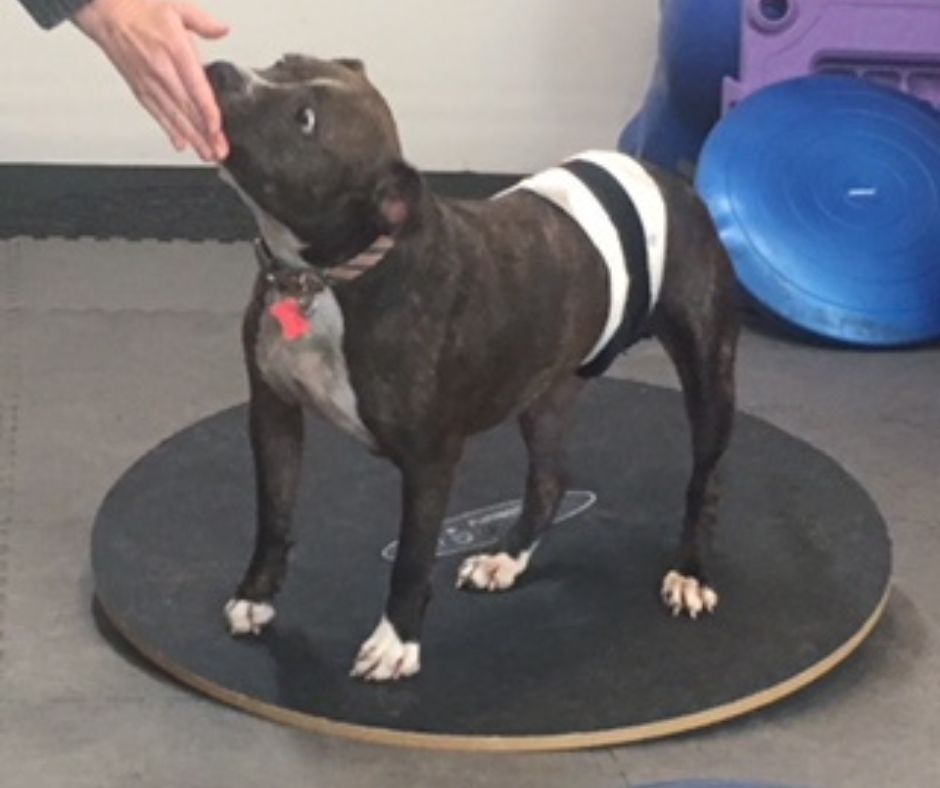
There are many ways we can help our dogs live happier and healthier lives, and canine rehab can be one of these ways. It’s aimed at helping your dog achieve the best quality of life possible with the highest level of independence and function possible while decreasing pain.
Rehab can be an effective way to help your dog heal from a surgery or injury or deal with a mobility issue. Here’s what you can expect from canine rehab and how to prepare for your first session.
Check out this post if you’re wondering if you should consider canine rehabilitation.
What is Canine Rehab Therapy?Canine rehabilitation is a field of veterinary medicine that treats dogs for the treatment and ongoing management of injuries, pathologies, and functional impairments. Rehabilitation is practiced by a vet, but human physical therapists may also offer animal physical therapy.
Rehab vets are trained to perform an assessment of a canine patient’s gait, mobility, flexibility, strength, endurance, range of motion, and other functional activities. Additionally, they evaluate a dog’s medical history to develop a tailored plan of care with short and long-term goals.
How to Prepare for Your First Canine Physical Rehab SessionThere are some activities you can do in advance of your first session with a rehab vet to ensure it’s as productive as possible. First, pull together all of your dog’s medical records, including diagnostic tests and results of procedures like x-rays.
Or, you can request that your vet send your dog’s records directly. If you saw multiple vets, like your primary vet and a surgeon, have both send their medical records.
Also, keep track of any symptoms you may see. Is your dog limping? Does anything specific seem to bring this out or is it a regular issue? Document anything you think of that could be related and what, if anything, you are doing about it.
Last, consider your commitment to a treatment plan. Treating your dog’s mobility issues will likely not be a “one and done” appointment with a rehab vet.
It may include regular visits, supplements and medications, and regular work at home including walks and structured exercises. This takes time and money. So, consider what you can and are willing to do to be prepared when you meet with the vet.
What to Bring to Your First SessionIt’s a good idea to bring a copy of your dog’s medical records to the first appointment if you can or to confirm the rehab vet received them.
Additionally, bring your pet’s supplements and medications. You can also bring an updated listing with you instead. Also, bring any documentation your captured tracking any issues you’ve witnessed that your dog is having and the details.
What You’ll Do During Your First SessionAt AZ Canine Rehab, the initial consultation consists of two sessions that are 55 minutes each. The first is an evaluation. I discuss the medical history with you as well as your observations. You complete a new client registration form.
We get to know each other a bit, then I evaluate your dog. This includes a full-body physical evaluation. We discuss treatment goals as well, as your participation is vital to your dog’s successful outcome.
The evaluation includes placing your dog on a stance analyzer to determine how the dog is standing and shifting weight. This important tool can identify issues before they can be directly observed, and it provides an objective measurement a rehab vet relies on for evaluation.
Following this first consultation, I craft a customized treatment plan designed for your dog based on the medical records and my evaluation. This may include a combination of the following:
Doing the exercises at home can help to reduce the frequency of visits. Though, it’s a good idea to follow up in person to ensure they are done correctly and to follow up on progress. This way, we can modify based on how your dog is at that time.
Once I complete the treatment plan, I share the results of the evaluation and the plan with your primary vet. Additionally, I share updates as the treatment progresses.
Ultimately, follow-up appointments depend on your dog’s needs, goals, commitment to care, and financial abilities. Please know that I’m committed to helping you and your dog, regardless of where you’re at.
Follow-Up SessionsAt subsequent appointments, your dog returns to the office for a workout. We run through some of the exercise plan you have for continued work at home to make any needed adjustments. This could be postural changes or an exercise change.
Your dog may also get therapeutic treatments like cold laser or others, depending on his or her needs. Follow-up appointments may be 25 or 55 minutes.
Canine rehabilitation can be an effective way of helping dogs with a variety of medical needs. I hope this helps to demystify what happens during the initial and subsequent sessions!
Rehab can be an effective way to help your dog heal from a surgery or injury or deal with a mobility issue. Here’s what you can expect from canine rehab and how to prepare for your first session.
Check out this post if you’re wondering if you should consider canine rehabilitation.
What is Canine Rehab Therapy?Canine rehabilitation is a field of veterinary medicine that treats dogs for the treatment and ongoing management of injuries, pathologies, and functional impairments. Rehabilitation is practiced by a vet, but human physical therapists may also offer animal physical therapy.
Rehab vets are trained to perform an assessment of a canine patient’s gait, mobility, flexibility, strength, endurance, range of motion, and other functional activities. Additionally, they evaluate a dog’s medical history to develop a tailored plan of care with short and long-term goals.
How to Prepare for Your First Canine Physical Rehab SessionThere are some activities you can do in advance of your first session with a rehab vet to ensure it’s as productive as possible. First, pull together all of your dog’s medical records, including diagnostic tests and results of procedures like x-rays.
Or, you can request that your vet send your dog’s records directly. If you saw multiple vets, like your primary vet and a surgeon, have both send their medical records.
Also, keep track of any symptoms you may see. Is your dog limping? Does anything specific seem to bring this out or is it a regular issue? Document anything you think of that could be related and what, if anything, you are doing about it.
Last, consider your commitment to a treatment plan. Treating your dog’s mobility issues will likely not be a “one and done” appointment with a rehab vet.
It may include regular visits, supplements and medications, and regular work at home including walks and structured exercises. This takes time and money. So, consider what you can and are willing to do to be prepared when you meet with the vet.
What to Bring to Your First SessionIt’s a good idea to bring a copy of your dog’s medical records to the first appointment if you can or to confirm the rehab vet received them.
Additionally, bring your pet’s supplements and medications. You can also bring an updated listing with you instead. Also, bring any documentation your captured tracking any issues you’ve witnessed that your dog is having and the details.
What You’ll Do During Your First SessionAt AZ Canine Rehab, the initial consultation consists of two sessions that are 55 minutes each. The first is an evaluation. I discuss the medical history with you as well as your observations. You complete a new client registration form.
We get to know each other a bit, then I evaluate your dog. This includes a full-body physical evaluation. We discuss treatment goals as well, as your participation is vital to your dog’s successful outcome.
The evaluation includes placing your dog on a stance analyzer to determine how the dog is standing and shifting weight. This important tool can identify issues before they can be directly observed, and it provides an objective measurement a rehab vet relies on for evaluation.
Following this first consultation, I craft a customized treatment plan designed for your dog based on the medical records and my evaluation. This may include a combination of the following:
- Therapeutic exercises
- Cold laser therapy
- Manual therapy
- Thermotherapy
- Muscle stretching
- Transcutaneous electrical stimulation (TENS)
- Neuromuscular electrical stimulation (NMES)
- Education
Doing the exercises at home can help to reduce the frequency of visits. Though, it’s a good idea to follow up in person to ensure they are done correctly and to follow up on progress. This way, we can modify based on how your dog is at that time.
Once I complete the treatment plan, I share the results of the evaluation and the plan with your primary vet. Additionally, I share updates as the treatment progresses.
Ultimately, follow-up appointments depend on your dog’s needs, goals, commitment to care, and financial abilities. Please know that I’m committed to helping you and your dog, regardless of where you’re at.
Follow-Up SessionsAt subsequent appointments, your dog returns to the office for a workout. We run through some of the exercise plan you have for continued work at home to make any needed adjustments. This could be postural changes or an exercise change.
Your dog may also get therapeutic treatments like cold laser or others, depending on his or her needs. Follow-up appointments may be 25 or 55 minutes.
Canine rehabilitation can be an effective way of helping dogs with a variety of medical needs. I hope this helps to demystify what happens during the initial and subsequent sessions!

 RSS Feed
RSS Feed